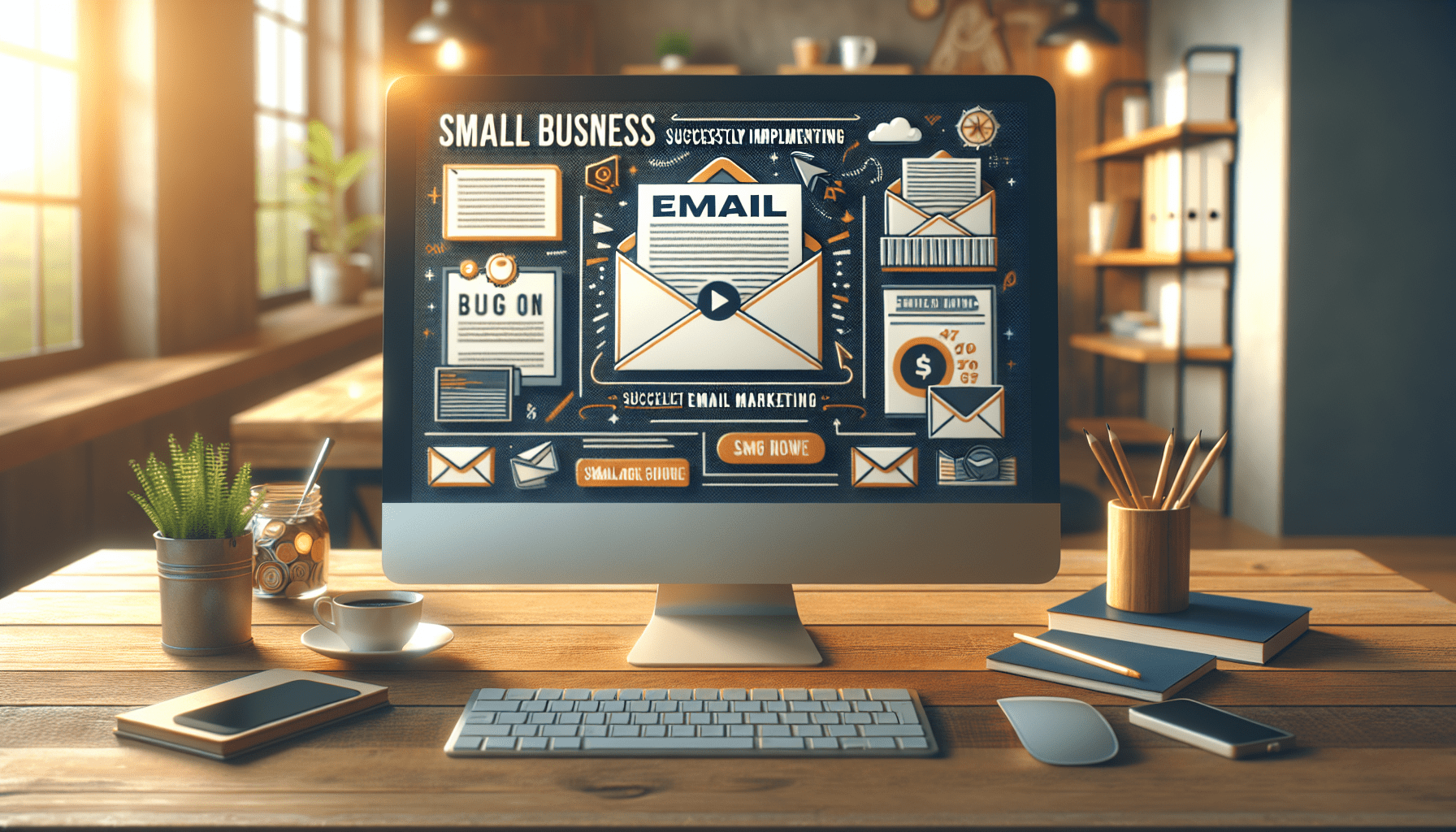
Are you a small business owner looking to enhance your email marketing strategies? Look no further! In this article, we will explore the most popular email marketing tactics that have proven to be effective for small businesses. From personalized content to enticing subject lines, you will discover the key elements to create engaging and successful email campaigns. Whether you are new to email marketing or seeking to improve your current strategies, this article is packed with valuable insights to help you achieve your goals. So let’s dive right in and start optimizing your email marketing efforts!

Understanding The Importance of Email Marketing
Email marketing plays a crucial role in the success of small businesses. With the rapid growth of digital marketing, email continues to be one of the most effective communication channels. It allows businesses to connect directly with their target audience, build relationships, and drive conversions. Email marketing offers a cost-effective way for small businesses to reach a large number of people, making it an essential tool for business growth.
In today’s digital world, where almost everyone has an email address, email marketing remains relevant and effective. It provides businesses with a direct and personalized way to communicate with their customers. Unlike social media or other marketing channels, email allows you to have complete control over your messaging and interact with your audience on a one-to-one level. This level of personalization is essential for building trust and establishing long-term customer relationships.
Building A Quality Email List
Having a robust email list is crucial for the success of your email marketing efforts. Without a quality email list, your campaigns may not reach the right audience or generate desired results. A well-built email list ensures that your messages are delivered to people genuinely interested in your products or services, increasing the likelihood of conversions.
To build a quality email list, you need to employ effective strategies. One such strategy is offering valuable incentives or lead magnets in exchange for email addresses. These can be in the form of e-books, discount codes, or exclusive content. By providing something of value, you encourage users to willingly share their contact information with you. Additionally, you can optimize your website with opt-in forms and pop-ups to capture email addresses from visitors.
Another strategy to enhance your email list is through list segmentation. List segmentation allows you to divide your email list into smaller, more targeted groups based on specific criteria like demographics, purchase history, or engagement level. This segmentation enables you to send more personalized and relevant content to each sub-group, increasing the chances of engagement and conversions.
Personalization and Targeting
Personalization is the cornerstone of successful email marketing. When emails are tailored to individual recipients, they feel more meaningful, leading to increased open rates, click-through rates, and conversions. By incorporating personalization in your email campaigns, you show your customers that you understand their needs and preferences, building trust and loyalty.
Utilizing customer data is crucial for targeted email campaigns. This data can include demographics, past purchases, browsing behavior, or engagement history. By leveraging this information, you can create highly targeted and relevant emails that resonate with your audience. For example, if a customer has recently purchased a product, you can send them a follow-up email with related products or accessories. This personalized approach enhances customer experience and encourages repeat purchases.
Successful personalized email campaigns abound in various industries. For instance, an online clothing retailer can send emails tailored to the recipient’s style preferences, showcasing items they are likely to be interested in. By addressing the recipient by name and providing personalized product recommendations, the retailer establishes a personal connection and increases the likelihood of conversion.
Creating Compelling Content
Crafting compelling email content is crucial for capturing your readers’ attention and driving engagement. The subject line is the first thing recipients see, and a poorly written one may lead to your email being ignored or deleted. To write an engaging subject line, you need to be concise, clear, and enticing. Use action words, create a sense of urgency, or ask a compelling question to pique curiosity. Experimenting with different subject lines and analyzing their performance can help you find what works best for your audience.
The body of your email should continue the captivating momentum of the subject line. Use a friendly, conversational tone to connect with your readers. Keep the content concise, easily scannable, and visually appealing. Break it into sections, use bullet points, and include relevant images or videos. Focus on providing valuable information, offering solutions to problems, or showcasing new products or services. Remember to include a clear call-to-action (CTA) that directs readers to your desired goal, such as making a purchase or signing up for a newsletter.
When it comes to email content, case studies provide valuable insights into effective strategies. For example, a software company can create a case study highlighting how their product helped a specific customer solve a problem. By sharing the customer’s success story and the measurable results achieved, the company showcases the real-world benefits of their product, increasing credibility and driving conversions.
Using Automation in Email Marketing
Automation is a powerful tool that can streamline your email marketing efforts, saving you time and ensuring consistency. With automation, you can set up emails to be sent automatically based on triggers or predefined schedules. This allows you to deliver timely and relevant content to your subscribers without manual intervention.
There are a variety of tools available to automate your email marketing campaigns. These tools often come equipped with features such as drip campaigns, where a series of pre-written emails are sent to subscribers based on their actions or time intervals. Additionally, automation tools provide A/B testing capabilities, allowing you to experiment with different variations of your emails to determine which ones perform better.
Successful email marketing automation can be seen in various industries. For example, an e-commerce store can use automation to send personalized abandoned cart reminders. When a customer adds items to their cart but doesn’t complete the purchase, an automated email can be triggered, reminding them of the items they left behind and offering an incentive to complete the purchase. This automation tactic helps recover potentially lost sales by capturing the attention of customers who may have been distracted or undecided.
Email Marketing Metrics and Analytics
Tracking email marketing metrics is essential for evaluating the success of your campaigns and identifying areas of improvement. These metrics provide valuable insights into the performance of your emails, helping you make data-driven decisions and optimize your strategies for better results.
Some important email marketing metrics to track include open rate, click-through rate, conversion rate, bounce rate, and unsubscribe rate. Open rate measures the percentage of recipients who opened your email, indicating its effectiveness in capturing attention. Click-through rate measures the percentage of people who clicked on a link within your email, showing the engagement level. Conversion rate tracks the percentage of recipients who complete a desired action, such as making a purchase. Bounce rate indicates the percentage of emails that were not delivered successfully, highlighting potential deliverability issues. Lastly, unsubscribe rate measures the percentage of people who opted out of your email list, reflecting the relevance and value of your content.
Analytics can help you improve your email marketing efforts by providing insights into subscriber behavior, preferences, and engagement patterns. By analyzing the data, you can identify trends, tailor your content to better meet your audience’s needs, and optimize your campaigns for maximum impact. Case studies showcasing analytics-driven email marketing success are abundant and demonstrate the power of utilizing data to drive measurable results.
Integration with Social Media Platforms
Social media and email marketing are complementary tools that, when integrated, can significantly enhance your marketing strategy. Social media platforms offer opportunities to expand your reach, build brand awareness, and engage with your audience. By combining email marketing with social media, you create a powerful synergy that can maximize your impact and drive conversions.
Social media plays a crucial role in email marketing by helping you grow your email list. By promoting your lead magnets, exclusive content, or special offers on social media, you can attract new subscribers and expand your reach. Additionally, you can include social media sharing buttons within your emails, allowing recipients to easily share your content with their networks, thereby increasing the likelihood of virality and reaching a larger audience.
Successful integration of social media and email marketing can be seen in various campaigns. For example, a fitness studio can run a social media contest where participants are required to provide their email addresses to enter. This strategy not only helps grow the email list but also creates buzz on social media, drawing attention to the brand and its offerings. By simultaneously engaging with potential customers on multiple platforms, the fitness studio increases the chances of conversion.
Optimizing Emails for Mobile Devices
In today’s mobile-driven world, optimizing emails for mobile devices is essential. With the majority of people accessing their emails on smartphones or tablets, it is crucial that your emails are easily readable and navigable on smaller screens. Failure to provide a seamless mobile experience may result in lower engagement and conversions.
To optimize emails for mobile devices, there are several best practices to follow. Firstly, make sure your email template is mobile-responsive, meaning it automatically adjusts to fit different screen sizes. This ensures that your content is displayed properly and is easy to read. Secondly, use a single-column layout to simplify the design and make scrolling easier. Avoid using small font sizes and large blocks of text, as these may be difficult to read on mobile devices. Lastly, ensure that your call-to-action buttons are large and easy to tap, minimizing the risk of accidental clicks.
Successful mobile email campaigns can be inspiring. For example, a restaurant can send out mobile-friendly emails with visually enticing images of their daily specials. By providing clear calls-to-action such as “Order Now” or “Reserve a Table,” the restaurant takes advantage of the convenience and immediacy of mobile devices, making it easy for recipients to take action and engage with their brand.
Ensuring Your Email is not marked as Spam
Avoiding being marked as spam is crucial for the success of your email marketing campaigns. Spam filters are designed to protect recipients from unsolicited and potentially harmful messages, but they can also catch legitimate emails if certain guidelines are not followed. To maximize the chances of your emails reaching the inbox instead of the spam folder, it is important to understand how spam filters work and employ key strategies.
One strategy is to focus on sending relevant and valuable content. Avoid using excessive capitalization, misleading subject lines, or excessive use of sales language. These practices may trigger spam filters and decrease the deliverability of your emails. Additionally, ensure that you have obtained permission from your subscribers to send them emails by implementing proper opt-in methods. Making it easy for recipients to unsubscribe or manage their preferences can also build trust with your audience and prevent them from reporting your emails as spam.
The return on investment in email deliverability is significant. By maintaining a good sender reputation and avoiding being marked as spam, you increase the likelihood of your emails reaching the intended recipients, maximizing your chances of engagement and conversions.
Holidays and Event-based Email Marketing
Leveraging holidays and events for your email marketing campaigns is an effective way to connect with your audience during special occasions and capitalize on the heightened engagement. Holidays offer opportunities to showcase your products or services in a unique and festive context, while event-based email marketing allows you to align your messaging with specific events or milestones.
When planning holiday-based email marketing campaigns, it is essential to start early and create a strategy that aligns with the specific holiday theme or sentiment. Whether it’s Christmas, Thanksgiving, or Valentine’s Day, your emails should reflect the spirit of the occasion. Offering exclusive discounts, limited-time promotions, or special holiday-themed products can entice your subscribers and drive conversions.
Event-based email marketing allows you to target specific events that are relevant to your audience. Whether it’s a product launch, a company anniversary, or a customer’s birthday, sending personalized emails on these occasions can make recipients feel appreciated and valued. By tailoring your messaging and offers to each event, you create a sense of exclusivity and enhance the customer experience.
Case studies of successful event-based email campaigns showcase the effectiveness of this strategy. For instance, a travel agency can send personalized emails to customers on their anniversary, offering them exclusive discounts on vacation packages. By acknowledging the special milestone and tailoring the offer to their travel preferences, the agency demonstrates their commitment to customer satisfaction and builds loyalty.
In conclusion, understanding the importance of email marketing and implementing effective strategies is essential for small businesses to thrive in today’s digital landscape. By building a quality email list, personalizing and targeting your campaigns, creating compelling content, utilizing automation, tracking metrics and analytics, integrating with social media, optimizing for mobile devices, avoiding spam filters, and leveraging holidays and events, you can maximize the impact of your email marketing efforts and drive meaningful results for your business.




